War threats before a major political election had been effective in the past in swinging the South Korean electorate to the right, but not this year. The conservative camp is battered and split into two warring parties following the impeachment of former President Park Geun-hye. The general public—its collective consciousness heightened through the mass protests that successfully ousted Park—is no longer rallying behind hawkish candidates who fan public paranoia to garner votes.Barring a last-minute surprise upset, liberal democrat
Moon Jae-in will be the next president of South Korea. But does he truly represent the interests of the millions who took to the streets to unseat Park and demand systemic change? And what are the tasks facing the left vis a vis the new administration? These are the questions this article will discuss, but first, let's quickly review the field of candidates.
A Brief Run-down of the CandidatesMoon Jae-in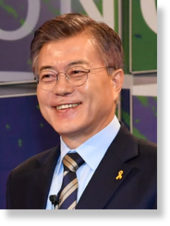
Moon Jae-in
Front-runner Moon Jae-in is arguably the greatest beneficiary of the mass protests that led to Park's impeachment. Widespread discontent against Park and her party as well as the public's desire for political change have catapulted Moon of the main opposition Minjoo Party to the front of the pack with a significant lead over all other candidates.
Moon was the Chief of Staff for the late former
President Roh Moo-hyun, who ruled from 2003 to 2008 and continued his predecessor
Kim Dae-jung's "sunshine policy" of engagement and economic cooperation with North Korea. If elected, Moon will likely reverse South Korea's policy toward North Korea to one of engagement. He has
pledged to reopen the Kaesong Industrial Complex—the joint inter-Korean economic project that was the last remaining hallmark of peaceful North-South engagement before it was shut down by the Park Geun-hye administration in 2016.
The question is, if Moon is elected, will the United States be willing to recalibrate its strategy to allow Moon to lead? And if not, how much will Moon stand up to the United States to chart an independent path?
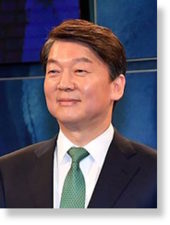
Ahn Cheol-soo
The runner-up, according to polls, is
Ahn Cheol-soo, who defected from the Minjoo Party to establish the centrist People's Party in the lead-up to the 2016 general election. His public branding as a successful entrepreneur and political outsider had once made him wildly popular among young people. But his rightward shift in an attempt to court the conservative vote in the aftermath of Park's impeachment has estranged him from his former fans. He promotes strengthening South Korea's alliance with the United States and expanding it to a "comprehensive strategic alliance" that includes closer cooperation not just militarily but also in the areas of politics, economy and culture.
Hong Jun-pyo 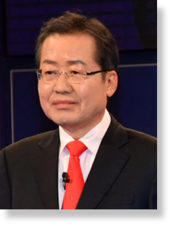
Hong Jun-pyo
Neck and neck with Ahn is
Hong Joon-pyo, the governor of South Gyeongsang province and the candidate of the Liberty Korea Party, the right-wing faction of the conservative split. Hong has appealed to South Korea's far right by doubling down on his conservative positions and slinging mud at his liberal opponents. He has
said he wants to bring U.S. tactical nuclear weapons to South Korea and has blamed gay people for the spread of HIV/AIDS.
Sim Sang-jung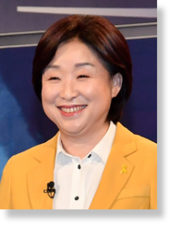
Sim Sang-jung
Support for
Sim Sang-jung of the left-leaning Justice Party climbed to a record 11.4 percent in the week leading up to the election. Disaffected voters disappointed by Ahn Cheol-soo's rightward shift are turning to Sim whose progressive and principled stance on issues such as LGBT rights appeals to young voters seeking change. After splitting off in 2012 from the Unified Progressive Party, which was forcibly dissolved a few years later by Park Geun-hye, the Justice Party has embraced pragmatism over left ideology and rebranded itself as a reformist party to appeal to a broader public. The leaders of the party will likely take official positions in the new liberal democratic administration. Whether the party can consolidate forces on the left to build on the momentum of the mass movement that ousted Park and push for systemic change remains doubtful.
Yoo Seong-min
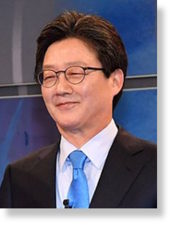
Yoo Seong-min
Trailing far behind the rest of the pack is
Yoo Seong-min, who represents the moderate, anti-Park faction of the conservative camp. He once served as Park Geun-hye's chief of staff when she was a lawmaker in the National Assembly. But the two grew apart when his open criticisms of her policies drew her ire and he was excluded from the Saenuri Party's nomination process in the 2016 general election. During Park's political scandal, Yoo left the Saenuri Party to help found the splinter Bareun Party. His strongest base is in the conservative stronghold of Daegu and North Gyeongsang province.
Whoever is President, the Mass Movement Cannot RestPark's historic impeachment, which created the opportunity for the upcoming election, did not come about through the political strength or deft maneuvering of the opposition parties.
It was the organized power of millions of ordinary people, who rejected Park's corrupt rule and took to the streets week after week, that pushed the wavering opposition parties into action.And that mass movement has now just about handed the presidency to Moon Jae-in. As a liberal democrat, Moon is far better than Park whose authoritarian rule rolled back decades of gains made by the country's pro-democracy forces. But his party has done little to challenge the previous administration's
labor market reform initiative or block the ongoing
deployment of a controversial U.S. missile defense system in Seongju. South Korean progressives note with bitterness that negotiations on the Korea-US Free Trade Agreement, which has led to
privatization of public services, such as healthcare, began when Moon was in the Blue House as the chief of staff for former President Roh Moo-hyun.
Clearly, the mass movement that ousted Park cannot rest after May 9 if it wants real change.
Perhaps the greatest tragedy of this year's election is that while people power created a historic opportunity for change, there is no political party that can consolidate that power and build on its momentum to fight for issues that are important to the broad majority of working people.A decade of conservative rule—from Lee Myung-bak to Park Geun-hye, who jailed many opposition leaders, including
Han Sang-gyun, the president of the Korean Confederation of Trade Unions, and forced the
dissolution of the opposition Unified Progressive Party—has battered and fragmented South Korea's organized left. Whoever is president after May 9, the left has a lot of ground to regain.
The Rise and Fall of the Democratic Labor PartyThe South Korean left's entry into the political arena has its roots in the mass uprisings of 1987, a pivotal year for the country in many regards. The decades-long South Korean struggle for democracy culminated in the June people's uprising of 1987
and finally put an end to a succession of U.S.-backed military dictatorships. The following months of
mass labor strikes in industrial manufacturing zones across South Korea laid the groundwork for the eventual formation of the Korean Confederation of Trade Unions. And for the first time since the division of Korea in 1945, masses of South Koreans openly called for reconciliation towards peaceful reunification. The formation of the National Council of Student Representatives (Jeondaehyeop) led to South Korean participation in the 13th World Festival of Youth and Students in Pyongyang in 1989 and the historic, defiant crossing of the DMZ by the late
Reverend Moon Ik-hwan and then-student activist
Lim Su-kyung.
1987,
paradoxically, also marked the year that South Korea's economy, once tightly controlled by an autocratic state,
began its transition to a neoliberal market economy modeled after Reagonomics. Thus, the South Korean political forces post-1987 comprised of a political and economic ruling class that embraced neoliberalism and trampled on the rights of workers in the name of "globalization," on the one hand, and a new democratic force borne out of militant resistance against the system of national division and capitalist exploitation on the other.
Despite major political differences on questions of strategy, the forces at the helm of the pro-democracy struggle, labor unions and social movement organizations joined together in 1987 to form the People's Victory 21, which became the foundation for the establishment of the Democratic Labor Party (DLP) in 2000. The DLP went on to garner 13% of the general vote and gain ten National Assembly seats to become the third largest political party in South Korea in 2004. Its success in 2004 was due in part to a change in election law, which, for the first time, allowed proportional representation, but it would not have been possible without disparate political forces reaching beyond their differences to come together in a united front.
For a relatively small party, the DLP played a key role in South Korean politics from 2000 to 2008. Through direct democracy, the party kept itself firmly rooted in the struggles of workers, farmers and the urban poor, who made up the majority of its membership. Its principled and persuasive positions on behalf of politically marginalized sectors forced the established parties to adopt progressive reforms and had the effect of pulling South Korea's entire political spectrum to the left. Before its forced dissolution in 2014, the DLP's heir, the Unified Progressive Party was the most vocal opponent of Park Geun-hye's policies on a range of issues, from privatization of public services to her hostile stance towards North Korea.
In the last two decades, South Korea's political and economic system began to show signs of faltering. The inter-Korean summits between Kim Dae-jung and Kim Jong-il in 2000 and Roh Moo-hyun and Kim Jong-il in 2007 shook the very foundation of South Korea's decades-old political system based on national division.
South Korea's economy, which once grew rapidly through neoliberal policies that forced its workforce to tighten their belts and endure longer and harsher working conditions, faced persistent crises, and its core, festering with corrupt collusion between the country's largest conglomerates and the government, is now laid bare for the entire world to see.
The mass candlelight protests of 2008—which brought out tens of thousands to protest the reversal of a U.S. beef import ban as part of South Korea's free trade negotiations with the United States—
and the recent protests to oust Park Geun-hye were the embittered expressions of a populace frustrated with the country's outdated political and economic system and in search of an alternative. The words to their anthem, sung in unison at every candlelight protest, is article one of the constitution: "The Republic of Korea is a democratic republic. All state authority shall emanate from the people." More than just expressions of discontent over rotten beef or the president's secret shamanic advisor scandal, the protests raised a fundamental question: the meaning of true sovereignty.
The left, unfortunately, has not provided an answer. Friction due to political differences on questions of strategy led to a split in the DLP in 2008 and created deep rifts within the South Korean left. 2008 also marked the beginning of a decade of conservative rule, which systematically eroded the gains made by the pro-democracy forces in the previous decades. The previous Park Geun-hye administration's transgressions against the people—from its mishandling of the Sewol Tragedy to its
backdoor deal with the Japanese government to silence the former "comfort women" who endured sexual slavery by the Japanese imperial army during WWII—are too many to enumerate.
What's more egregious is the incompetence of the existing opposition parties that have failed to stand up to these overt acts of authoritarianism. The undisguised degeneration of South Korean politics and the rightward shift of the opposition parties are a direct result of the marginalization and isolation of the organized left following the DLP's break-up.
Time to Regain Lost GroundThe South Korean people, who declared "Basta ya!" and gave Park Geun-hye the boot are still fighting—in the melon fields of
Seongju, by the watery grave at
Paengmok Harbor and on picket lines small and big across the country. Whoever wins the election on May 9, the mass movement that ousted Park will need to build on the momentum of its victory and keep the pressure on in a number of fronts.
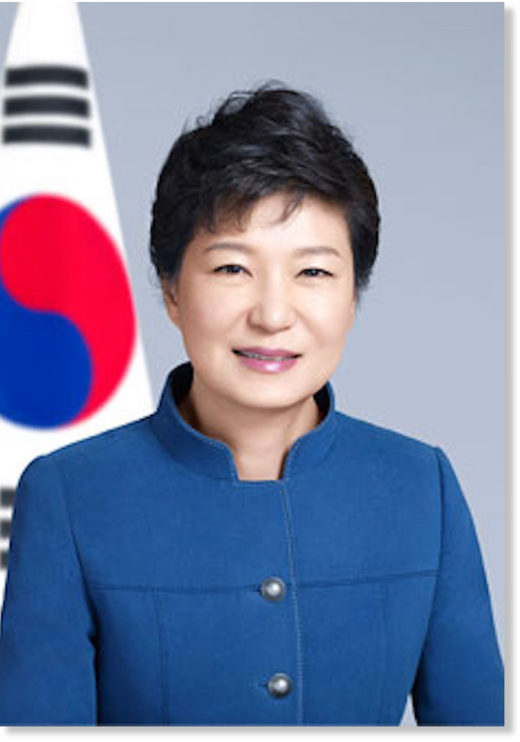
Former President Park Geun-hye
The most pressing task for the new administration will be to mediate the current crisis between the United States and North Korea. Despite Trump's declared willingness to sit down with
Kim Jong-un, no one—not even China—is able to broker such a meeting. That has to be the task of the incoming South Korean leader.
For reconciliation with the North and permanent peace on the peninsula, the South Korean people will need to press the new administration to stand up to the Trump administration and chart an independent path. Demanding the United States end its provocative war exercises in exchange for a freeze of North Korea's nuclear and missile tests and withdraw its dangerous missile defense system in Seongju is now more urgent than ever.
The fight against the government's labor market reform initiative—aimed at turning South Korea's entire workforce into a disposable pool of temporary and precarious labor and undermining the power of unions—will intensify even with a liberal democrat in the Blue House. Unless the mass movement continues to press the next administration, the corrupt system exposed through the Park Geun-hye-Choi Soon-sil scandal—the cozy back-scratching relationship between South Korea's largest conglomerates and its political leaders—will remain unchanged.
Abolishing the National Security Law—mainly used to punish political opponents, dissolve social organizations and political parties and suppress progressive voices—is a task that even Moon Jae-in failed to do as Roh Moo-hyun's chief of staff. It will take an organized fight from the left to overturn the archaic law once and for all.
What the movement to impeach Park Geun-hye laid bare is that South Korea's current political and economic system is no longer sustainable. It also showed clearly that state power, which confines the democratic aspirations of the people, can also be pushed back by their organized power. The fissures in the political system exposed by their struggle are openings for the broader left.
But people power does not emerge spontaneously. Only when the people are organized through social movements and have a political party that can fight for their interests can they mount effective and sustained resistance to challenge the status quo. A left political party cannot exercise its power in the political arena without the organized social movement of the disenfranchised, who make up the party's base. Likewise,
without a political party that can fight for their interests in the political arena, social movements can easily be defeated. A unified political party fighting in tandem with a social movement of the organized masses is essential for systemic change.
After May 9, the movement that ousted Park cannot rest, as the South Korean majority seeks, as a matter of survival, a political force that will forge a new path. Creating that force—by building social movements and unifying the left to build political power—should be top on the agenda of everyone on the left. And supporting that effort should be a priority for all those outside Korea who were inspired by the awesome mass protests that toppled Park Geun-hye's regime.
Reader Comments
to our Newsletter